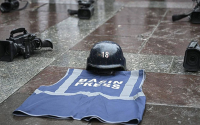9 October 2003The Sunshine Project
(Austin and Hamburg, 9 October 2003) – The 'Spanish Flu' influenza virus that killed 20-40 million people in 1918 is currently under reconstruction. Several genes of the extraordinarily lethal 1918 flu virus have been isolated and introduced into contemporary flu strains. These proved to be lethal for mice, while virus constructs with genes from a current flu virus types had hardly any effect. These experiments may easily be abused for military purposes, but provide little benefit from a medical or public health point of view.
The 1918 Spanish Flu was highly infectious and – in comparison to contemporary flu viruses – killed a very high percentage of those infected, including many younger people. The Spanish Flu alone caused the medium life expectancy in the US in 1918 to drop by 10 years. Hence, flu viruses are perceived today as a serious biological warfare threat. Just two weeks ago, a 15 million dollar research grant was awarded in the US to develop protective measures especially against a bioterrorist attack with flu viruses.
Despite the very dangerous nature of the 1918 virus, efforts to reconstruct it started in the mid 1990s, when Dr Jeffrey Taubenberger from the US Armed Forces Institute of Pathology in Washington DC succeeded in recovering and sequencing fragments of the viral RNA from preserved tissues of 1918 victims. In the current issue of the scientific journal Emerging Infectious Diseases new genetic details of the 1918 flu virus will be published.
But after (partially) unravelling the genetic sequence of the virus, the scientists went a step further and began bringing the Spanish flu back to life. Unnoticed by the public, they succeeded in creating a live virus containing two 1918 genes that proved to be very lethal in animal experiments. This experiment is only one genetic step away from taking the 1918 demon entirely out of the bottle.
A resuscitation of the Spanish flu is neither necessary nor warranted from a public health point of view. Allegedly, the recent experiments sought to test the efficacy of existing antiviral drugs on the 1918 construct. But there is little need for antiviral drugs against the 1918 strain if the 1918 strain had not been recreated in the first place "It simply does not make any scientific sense to create a new threat just to develop new countermeasures against it." says Jan van Aken, biologist with the Sunshine Project, "Genetic characterization of influenza strains has important biomedical applications. But it is not justifiable to recreate this particularly dangerous eradicated strain that could wreak havoc if released, deliberately or accidentally."
Construction of new maximum security (BSL-4) laboratories for biodefense research has been justified in part by citing the potential of the Spanish Flu as a biological weapon. Influenza usually requires a low level of containment; but when scientists begin recombining virulence-related genes, the danger dramatically increases. The University of Texas Medical Branch's BSL-4 plans influenza 'gene reassortment' experiments in maximum containment. "This kind of research is creating a vicious circle, and could prompt a race by biodefense scientists to genetic engineer unthinkable diseases", says Edward Hammond of the Sunshine Project, "What disease comes after influenza? Biodefense laboratories must not become self-fulfilling prophesy centers. The world does not need biodefense programs to create a 'genetically engineered disease gap'."
From an arms control perspective it appears to be particularly sensitive if a military research institution embarks on a project that aims at constructing more dangerous pathogens. "If Jeffery Taubenberger worked in a Chinese, Russian or Iranian laboratory, his work might well be seen as the 'smoking gun' of an offensive biowarfare program," says van Aken.






